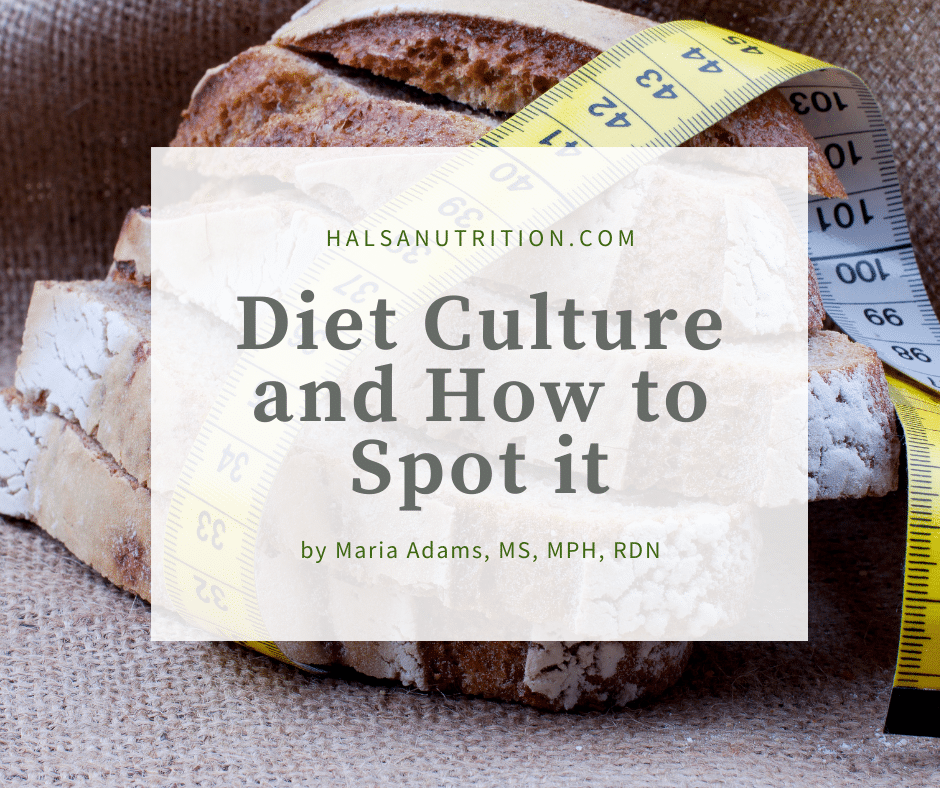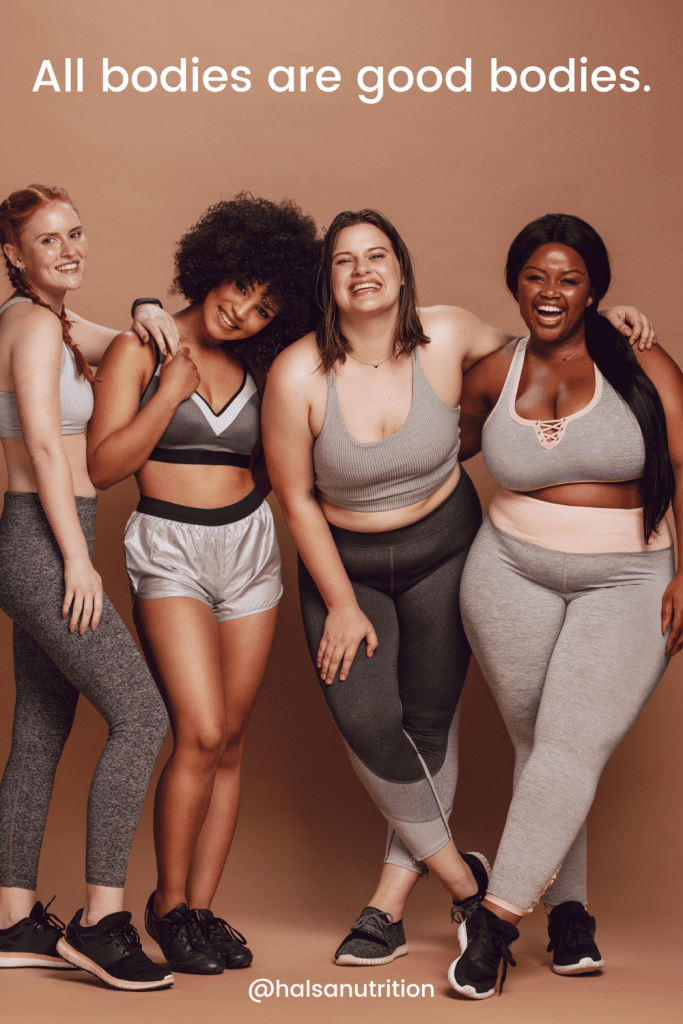
Diet Culture and How to Spot it
Diet culture is everywhere these days. Learn more about what it is, why it’s harmful, and how to spot it.

If you had asked me 15 years ago to talk about the harms of diet culture I wouldn’t have totally understood what you meant. Like most well-intentioned dietitians and health practitioners, I was immersed in it myself without even realizing it.
Fortunately, I now recognize it and want to help others do so too. You don’t have to be on a diet or have ever dieted to be affected by diet culture. It’s the culture most of the world lives in today.
What is Diet Culture?
So what is diet culture? Christy Harrison, MS, RD, author of the must-read book “Anti-Diet – Reclaim Your Time, Money, Well-Being, and Happiness Through Intuitive Eating” and host of the podcast “FoodPsych” defines it like this:
A system of beliefs that:
- equates thinness, muscularity, and particular body shapes with health and moral value;
- promotes weight loss and body reshaping as a means of attaining higher status;
- demonizes certain foods and food groups while elevating others;
- and oppresses people who don’t match its supposed picture of health. (Source)
So basically, if you have ever felt thinner or more muscular bodies are healthier or more worthy than larger bodies, tried to lose weight, been afraid of weight gain, or considered some foods or food groups “bad” or “unhealthy”, you have been immersed in diet culture.
Why We Need to Unlearn Diet Culture
The traditional school of thought is that it’s healthier to be thinner, but more and more research is showing that this just isn’t true. Your weight or BMI doesn’t determine your health! There are many people in thin bodies who are unhealthy and many people in larger bodies who are healthy. There is so much more than one’s weight that goes into determining health. In fact, the whole BMI scale is flawed, more on that in another post.
In addition to weight not determining health, diet culture is causing harm.
- It leads to weight bias and stigma. Some bodies are viewed as worthier than others and this is not right. Studies show that people in larger bodies face higher levels of discrimination. (Source) They may even be treated differently than smaller-bodied individuals when they go to the doctor. (Source)
- Focusing on weight and body size also increases the risk of disordered eating. And disordered eating increases the risk of developing a full-blown eating disorder. (Source)
- Research shows only about 5% of people can sustain intentional weight loss for more than a few years. (Many sources, but here is the original: source) In addition, more than two-thirds of people who lose weight, regain more weight than they lost. (Source) In other words, dieting doesn’t work in the long run.
- Finally, as Harrison emphasizes with the title of her “Anti-Diet Book”, diet culture steals our time, money, well-being, and happiness.
How to Spot Diet Culture
The first step to unlearning diet culture is recognizing its presence.
In the past decade or so, as people have caught on that dieting isn’t as cool as it used to be, diet culture has rebranded itself. So rather than spinning itself as a diet, the latest plans, programs, and books may spin themselves as being all about your health and fitness instead. But most are still ultimately equating thinness with health.

Here are some ways to recognize diet culture:
- SNEAKY WORDS – Be on the lookout for sneaky diet terms like “clean eating”, “detox”, “reset”, or “wellness protocol/plan/diet”. One of my least favorite new ones is “Intuitive Fasting”.
- FOOD TRACKING – If you have to track your calories, serving sizes, or macros, it’s a diet.
- JOYLESS MOVEMENT – Exercise/movement should be joyful. It shouldn’t feel forced or like punishment. Sure it may be “tough” and “challenging”, but hopefully in a good way. A good program will be flexible, meet you where you are at, and recognize that rest is equally important!
- FOOD RULES – Nutrition guidelines can be helpful, for example, it’s great to aim to consume enough veggies, water, Vitamin D, etc. However, be wary of anything that limits the amount you can eat, restricts the hours of the day that you can eat, or tells you to avoid certain types of foods. (Instead, learn about intuitive eating!)
- FOOD LABELING – Be on the lookout for food labeling, for example, “good” vs “bad” or “healthy” vs “unhealthy”. Labeling foods in this way can lead you to feel guilty after eating the “bad” ones, increase your risk of orthorexia, and teach kids that certain foods should be feared or avoided.
- BODY FOCUS – All bodies are good bodies and we come in all shapes and sizes. Look for health recommendations or practitioners that focus on your overall well-being, not your weight. Weight does not determine health. Moreover, weight is not a behavior!

Take Away Message
In conclusion, diet culture is causing unnecessary harm. It’s time to shift our focus from weight and diet to overall health and well-being instead. To start, know that all bodies as good and worthy and that size doesn’t determine health. Everyone has the right to health, regardless of size or appearance.
It’s also important to realize that pursuing health is not a moral obligation. So rather than pushing diet culture tactics such as weight loss or diet restrictions a way to improve the health of our society, let’s focus on promoting health in a more holistic way, one that is attainable to all.
Stay tuned for more posts on HAES® (Health at Every Size), Why the BMI Scale is Flawed, and Ways to Help Your Kids Become Intuitive Eaters.
Related Posts
- HAES – A Better Approach to Health and Weight
- Discover the Joy of Intuitive Eating
- Diet Culture and Food Language
- Calorie Information: Helpful or Harmful?
- Why You Should Skip the Diet this Year (and Every Year)
- The Problem with “Clean Eating”
- Help Your Child Establish a Positive Relationship with Food
Leave a Reply